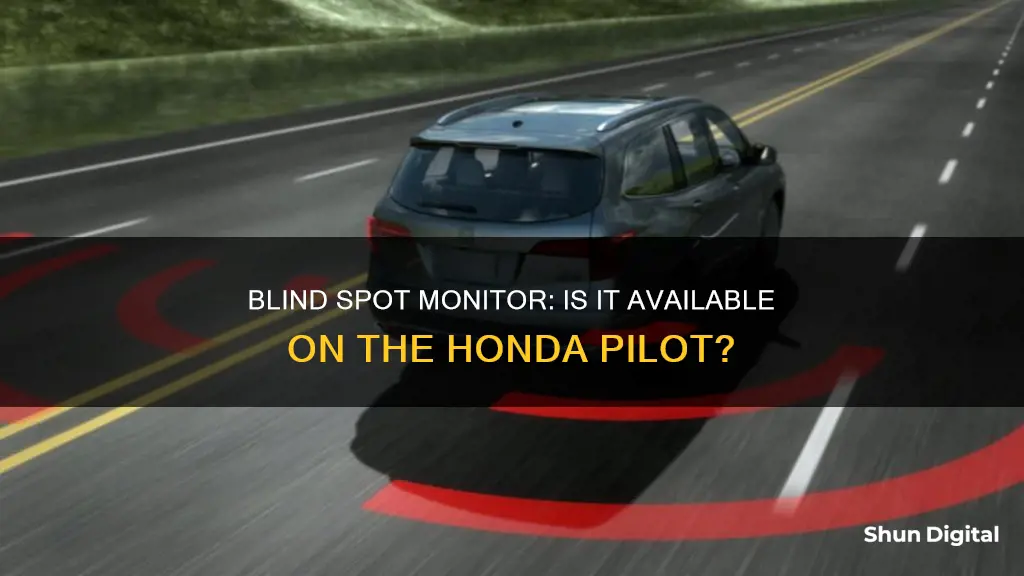
The Honda Pilot is a midsize SUV that offers a spacious interior, powerful engine, and advanced safety features. One of the safety features included in the Honda Pilot is the Blind Spot Information System (BSI). This system is designed to increase driver awareness and help detect vehicles on either side of the car, alerting the driver if they are attempting to move into an occupied lane. The BSI uses sensors to detect vehicles in the blind spot and alerts the driver with a warning light on the side mirror. The Honda Pilot also comes with a rear cross-traffic monitor and a multi-angle rearview camera with dynamic guidelines, providing a clear view of the vehicle's surroundings and helping to avoid collisions.
| Characteristics | Values |
|---|---|
| Blind Spot Monitoring System | Blind Spot Information System (BSI) |
| How it works | A pair of sensors, one on each rear corner of the vehicle, detect vehicles in adjacent lanes. |
| Alerts | Visual (indicator light on side mirror or at the base of the A-Pillar) and audible (beeping sound) alerts for the driver. |
| Activation speed | The system activates when the vehicle achieves a forward speed of at least 20 mph. |
| Coverage | Covers an area of about 10-13 feet to the side of the vehicle and 10-15 feet rearward. |
| Additional features | Cross-Traffic Monitor, Lane Keeping Assist System (LKAS), Adaptive Cruise Control (ACC). |
What You'll Learn

The Honda Pilot's Blind Spot Information System (BSI)
The Honda Pilot is a midsize SUV that offers a spacious interior, powerful engine, and advanced safety features. One of these features is the Blind Spot Information System (BSI), which is designed to increase driver awareness and help prevent collisions.
The Honda Pilot's Blind Spot Information System uses a pair of sensors, one on each rear corner of the vehicle, to detect vehicles or objects in the adjacent lanes. When the system detects something in the blind spot zone, it alerts the driver through visual and audible warnings. An indicator will light up at the base of the respective A-pillar or side mirror, and if the turn signal is activated, the indicator will flash and an alert will sound to catch the driver's attention.
The BSI system in the Honda Pilot is engineered for relatively close range, covering an area of about 10 to 13 feet to the side of the vehicle and 10 to 15 feet back from the front doors or rear bumper. To prevent false alarms at low speeds, the system is disabled below approximately 6 mph. Additionally, the system includes a maximum speed difference threshold, which means the indicator will not activate when driving past parked cars or for opposing traffic in the lane to the left.
The Honda Pilot's BSI system is designed to work in conjunction with other safety features such as the Cross Traffic Monitor and the multi-angle rearview camera with dynamic guidelines. These features provide a clear view of the vehicle's surroundings and help drivers avoid collisions when backing up, changing lanes, or merging into traffic.
The Blind Spot Information System is a valuable safety feature that enhances driving confidence and peace of mind. It is just one example of Honda's commitment to providing advanced driver-assist technologies that improve safety and make the driving experience more enjoyable.
Choosing the Right Monitor Size for Your MAME Cabinet
You may want to see also

How BSI works
The Honda Blind Spot Information System (BSI) is designed to enhance driver awareness and increase driving confidence. The system uses radar to scan for vehicles occupying the driver's blind spot, providing additional information about conditions on both sides of the vehicle.
The BSI system covers an area of approximately 10 feet to each side of the vehicle and 15 feet back from the front doors. This area is monitored by a pair of sensors, one located on each rear corner of the vehicle. When the system detects a vehicle in the adjacent lane, a visual warning is displayed on the side mirror. If the driver activates the turn signal to change lanes, the visual warning will blink, and an audible beep will sound to alert the driver.
The BSI system can be customised through the Settings menu on the Display Audio touchscreen. Drivers can choose from Audible and Visual Alert, just Visual Alert, or disable the system completely. It is important to note that the BSI system is designed to supplement, not replace, the driver's own visual assessment before changing lanes. The system may not detect all objects, and its accuracy can be affected by factors such as weather conditions, object size, and speed.
The Honda BSI system is available on select Honda models, including the 2022 Honda Pilot SUVs. The system activates when the vehicle achieves a forward speed of at least 20 mph. After driving on straight roads with traffic, the system will adapt and expand the alert zone up to about 82 feet behind the rear bumper.
Troubleshooting Monitor Issues: Button Panel or Power Supply?
You may want to see also

BSI's benefits
The 2023 Honda Pilot is equipped with a Blind Spot Information (BSI) System, an innovative feature that enhances driver confidence and safety on the road. Here are some key benefits of the BSI system:
Enhanced Situational Awareness:
The BSI system uses advanced sensors and cameras to detect objects within the driver's blind spots, providing valuable information about conditions on both sides of the vehicle. This helps drivers make more informed decisions and improves their overall situational awareness, leading to safer driving.
Increased Driving Confidence:
By offering additional details about the vehicle's surroundings, the BSI system boosts the driver's confidence. Knowing that the system is actively monitoring blind spots and providing alerts can make drivers feel more assured and in control, especially when navigating busy roads or changing lanes.
Improved Road Safety:
The BSI technology significantly contributes to road safety. The system alerts drivers to the presence of vehicles or objects in their blind spots, reducing the risk of collisions or accidents. This is especially beneficial when driving on highways or making lane changes, as it minimizes the chances of sideswiping nearby vehicles.
Adaptable Alert Zone:
The BSI system in the Honda Pilot is designed to adapt and expand its alert zone. Initially covering an area of about 10 feet rearward and 10 feet out from each side of the vehicle, the system can extend its coverage up to approximately 82 feet behind the rear bumper after driving for some time on straight roads with traffic. This adaptability ensures that drivers receive timely alerts based on changing road conditions.
Visual and Audible Alerts:
The BSI system employs both visual and audible alerts to effectively capture the driver's attention. When an object is detected in the blind spot, an indicator lights up in the appropriate side mirror, and if the turn signal is activated in that direction, the indicator flashes, and an alert sounds, ensuring that drivers are promptly notified of potential hazards.
The BSI system in the Honda Pilot is an excellent example of how modern automotive technology can enhance the driving experience and improve safety. By providing drivers with crucial information about their surroundings, the BSI system empowers them to make better decisions and reduces the risk of accidents.
Understanding Monitor Color Spaces: A Guide to Calibration
You may want to see also

Honda's previous LaneWatch system
The system was well-liked for its simplicity and practicality. Even with mirrors properly adjusted to account for blind spots, LaneWatch provided an additional layer of safety when changing lanes. However, Honda began phasing out the LaneWatch system in favour of traditional blind-spot monitoring systems in 2019. This shift was likely due to the decreasing cost of radar sensors and the fact that LaneWatch could only monitor one lane, whereas traditional blind-spot monitoring systems typically cover two lanes.
By the end of 2018, 85% of new vehicles offered some form of blind-spot monitoring, and it had become a standard feature on many luxury cars. As of 2019, LaneWatch was only available on six Honda models: Civic, Clarity, Fit, HR-V, Insight, and Ridgeline. It is likely that LaneWatch will be discontinued on these models when they are redesigned.
Honda's current blind-spot monitoring system, the Blind Spot Information (BSI) System, uses a pair of sensors, one on each rear corner of the vehicle, to detect objects in adjacent lanes. When an object is detected, an indicator lights up in the appropriate side mirror to alert the driver. The system activates when the vehicle reaches a forward speed of 20 mph.
Understanding Monitor Resolution and Picture Size
You may want to see also

Other Honda models with blind spot monitoring
The Honda Pilot is a midsize SUV that comes equipped with Honda's Blind Spot Information System (BSI). This system uses sensors to detect vehicles in the driver's blind spot and provides visual and auditory alerts to help avoid potential collisions. In addition to the Honda Pilot, several other Honda models also offer blind spot monitoring as a standard or optional feature, enhancing safety and driver confidence.
One such model is the Honda Civic, a popular compact car known for its sporty design and fuel efficiency. The Civic features Honda's LaneWatch system, which utilizes a camera mounted on the passenger-side mirror to display a live video feed of the car's blind spot on the central touchscreen. This provides drivers with valuable visual information when changing lanes or merging into traffic.
The Honda Accord, a midsize sedan renowned for its spacious interior and advanced safety features, also includes the Blind Spot Information System. This system employs sensors mounted on the rear bumper to detect vehicles in the blind spot, alerting the driver with a warning light on the side mirror. Additionally, the Accord's cross-traffic monitor uses the same sensors to detect approaching vehicles when backing out of a parking spot.
The Honda CR-V, a versatile and comfortable compact SUV, is another model that incorporates the Blind Spot Information System. Similar to the Accord, the CR-V's system uses sensors to detect vehicles in adjacent lanes, providing peace of mind when changing lanes or merging with traffic.
The Honda Odyssey, a popular minivan, is also equipped with the Blind Spot Information System. In addition, the Odyssey offers a rear cross-traffic monitor and a multi-angle rearview camera with dynamic guidelines, ensuring a comprehensive view of the vehicle's surroundings and enhancing safety when backing up or changing lanes.
Lastly, the Honda Ridgeline, a midsize pickup truck, features the Blind Spot Information System as well. The Ridgeline also includes a rearview camera with dynamic guidelines and a cross-traffic monitor, making it easier to navigate tight spaces and improve overall safety when driving or manoeuvring.
Lace Monitor Buying: Where to Purchase Your New Pet
You may want to see also
Frequently asked questions
Yes, the Honda Pilot comes with Honda's Blind Spot Information System (BSI).
The system uses a pair of sensors, one on each rear corner of the vehicle, to detect vehicles in adjacent lanes. When an object is detected in the blind spot, an indicator will light up in the appropriate side mirror to alert the driver. If the driver then turns their signal on in the direction of the detected object, the indicator flashes and an alert sounds.
Blind spot monitoring is standard on all 2021, 2022, and 2023 Honda Pilot models. It is also available on some older models, such as the 2019 Pilot.
Blind spot monitoring is an important safety feature that helps drivers avoid collisions when changing lanes or merging into traffic. It provides additional information about conditions on both sides of the vehicle, enhancing the driver's confidence and safety.







